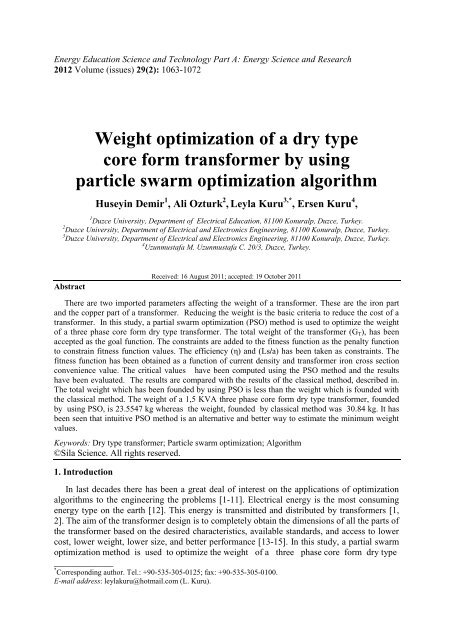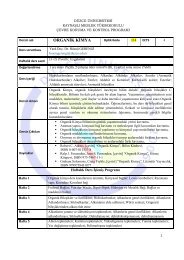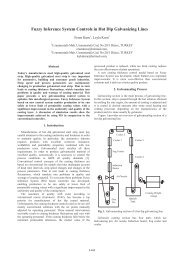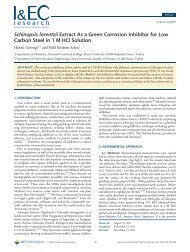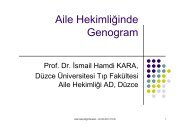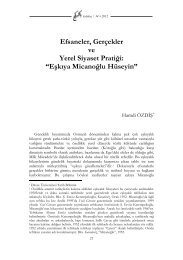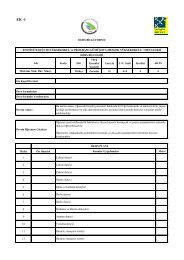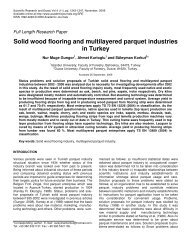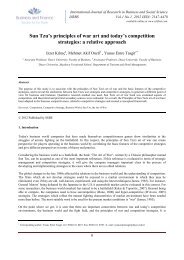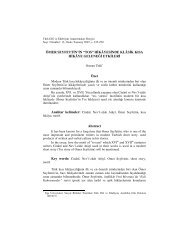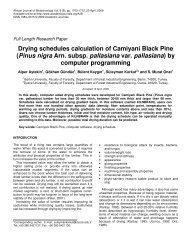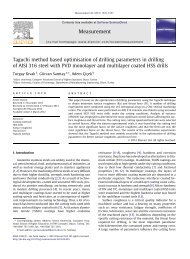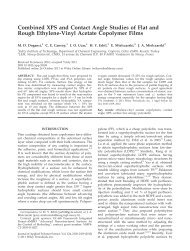Weight optimization of a dry type core form transformer by using ...
Weight optimization of a dry type core form transformer by using ...
Weight optimization of a dry type core form transformer by using ...
Create successful ePaper yourself
Turn your PDF publications into a flip-book with our unique Google optimized e-Paper software.
Energy Education Science and Technology Part A: Energy Science and Research<br />
2012 Volume (issues) 29(2): 1063-1072<br />
<strong>Weight</strong> <strong>optimization</strong> <strong>of</strong> a <strong>dry</strong> <strong>type</strong><br />
<strong>core</strong> <strong>form</strong> trans<strong>form</strong>er <strong>by</strong> <strong>using</strong><br />
particle swarm <strong>optimization</strong> algorithm<br />
Huseyin Demir 1 , Ali Ozturk 2 , Leyla Kuru 3,* , Ersen Kuru 4 ,<br />
1 Duzce University, Department <strong>of</strong> Electrical Education, 81100 Konuralp, Duzce, Turkey.<br />
2 Duzce University, Department <strong>of</strong> Electrical and Electronics Engineering, 81100 Konuralp, Duzce, Turkey.<br />
3 Duzce University, Department <strong>of</strong> Electrical and Electronics Engineering, 81100 Konuralp, Duzce, Turkey.<br />
4 Uzunmustafa M. Uzunmustafa C. 20/3, Duzce, Turkey.<br />
Abstract<br />
Received: 16 August 2011; accepted: 19 October 2011<br />
There are two imported parameters affecting the weight <strong>of</strong> a trans<strong>form</strong>er. These are the iron part<br />
and the copper part <strong>of</strong> a trans<strong>form</strong>er. Reducing the weight is the basic criteria to reduce the cost <strong>of</strong> a<br />
trans<strong>form</strong>er. In this study, a partial swarm <strong>optimization</strong> (PSO) method is used to optimize the weight<br />
<strong>of</strong> a three phase <strong>core</strong> <strong>form</strong> <strong>dry</strong> <strong>type</strong> trans<strong>form</strong>er. The total weight <strong>of</strong> the trans<strong>form</strong>er (G T ), has been<br />
accepted as the goal function. The constraints are added to the fitness function as the penalty function<br />
to constrain fitness function values. The efficiency (η) and (Ls/a) has been taken as constraints. The<br />
fitness function has been obtained as a function <strong>of</strong> current density and trans<strong>form</strong>er iron cross section<br />
convenience value. The critical values have been computed <strong>using</strong> the PSO method and the results<br />
have been evaluated. The results are compared with the results <strong>of</strong> the classical method, described in.<br />
The total weight which has been founded <strong>by</strong> <strong>using</strong> PSO is less than the weight which is founded with<br />
the classical method. The weight <strong>of</strong> a 1,5 KVA three phase <strong>core</strong> <strong>form</strong> <strong>dry</strong> <strong>type</strong> trans<strong>form</strong>er, founded<br />
<strong>by</strong> <strong>using</strong> PSO, is 23.5547 kg whereas the weight, founded <strong>by</strong> classical method was 30.84 kg. It has<br />
been seen that intuitive PSO method is an alternative and better way to estimate the minimum weight<br />
values.<br />
Keywords: Dry <strong>type</strong> trans<strong>form</strong>er; Particle swarm <strong>optimization</strong>; Algorithm<br />
©Sila Science. All rights reserved.<br />
1. Introduction<br />
In last decades there has been a great deal <strong>of</strong> interest on the applications <strong>of</strong> <strong>optimization</strong><br />
algorithms to the engineering the problems [1-11]. Electrical energy is the most consuming<br />
energy <strong>type</strong> on the earth [12]. This energy is transmitted and distributed <strong>by</strong> trans<strong>form</strong>ers [1,<br />
2]. The aim <strong>of</strong> the trans<strong>form</strong>er design is to completely obtain the dimensions <strong>of</strong> all the parts <strong>of</strong><br />
the trans<strong>form</strong>er based on the desired characteristics, available standards, and access to lower<br />
cost, lower weight, lower size, and better per<strong>form</strong>ance [13-15]. In this study, a partial swarm<br />
<strong>optimization</strong> method is used to optimize the weight <strong>of</strong> a three phase <strong>core</strong> <strong>form</strong> <strong>dry</strong> <strong>type</strong><br />
_____________<br />
* Corresponding author. Tel.: +90-535-305-0125; fax: +90-535-305-0100.<br />
E-mail address: leylakuru@hotmail.com (L. Kuru).
1064 H. Demir / EEST Part A: Energy Science and Research 29 (2012) 1063-1072<br />
trans<strong>form</strong>er which is designed previously [2]. There are two imported parameters affecting the<br />
weight <strong>of</strong> a trans<strong>form</strong>er. These are the iron part and the copper part <strong>of</strong> a trans<strong>form</strong>er [1]. In section<br />
2, PSO method is explained. In section 3, the solutions <strong>of</strong> the problem are explained. In<br />
section 3.1 the solution <strong>of</strong> the problem is done <strong>by</strong> classical method and in section 3.2 the<br />
solution <strong>of</strong> the problem is done <strong>by</strong> PSO. The total weight <strong>of</strong> a three phase <strong>core</strong> <strong>form</strong> <strong>dry</strong> <strong>type</strong><br />
trans<strong>form</strong>er is obtained as a function <strong>of</strong> the total iron and the total copper weights <strong>of</strong> the<br />
trans<strong>form</strong>er. This function has been accepted as the goal function. The constraints are<br />
added to the fitness function as the penalty function to constrain fitness function values. The<br />
efficiency (η) and (Ls/a) has been taken as the constraints. By <strong>using</strong> the given equations the<br />
fitness function has been obtained as a function <strong>of</strong> current density and trans<strong>form</strong>er iron cross<br />
section convenience value. The minimum values for this function were computed <strong>using</strong> the<br />
PSO method and finally the results are given in the conclusion part.<br />
2. Partial swarm <strong>optimization</strong> (PSO)<br />
PSO is a population-based <strong>optimization</strong> algorithm developed for the first time <strong>by</strong> [16]. It<br />
was inspired <strong>by</strong> the moving school <strong>of</strong> fish and swarm inspection. Basically, PSO is an<br />
algorithm based on swarm intelligence. It is similar to the computational techniques based on<br />
development such as genetic algorithms (GA). While PSO is searching for the optimum in the<br />
search space, it uses the population which holds the possible solutions for the function to be<br />
optimized [17]. Thus, each individual is called a particle. Particles make up the population<br />
called a swarm. In PSO, however, each member <strong>of</strong> the swarm has a variable speed which<br />
changes based on the conditions and determines its movement in the search space. In addition,<br />
each member has a memory holding the best spot previously visited. Each particle adjusts its<br />
position toward the best position in the swarm <strong>by</strong> taking the advantage <strong>of</strong> its previous<br />
experience. PSO is basically based on the fact that the positions <strong>of</strong> the particles in the swarm<br />
Fig. 1. The flow diagram for PSO.<br />
are brought closer to the best position in the swarm. The speed <strong>of</strong> “bringing closer” happens<br />
in a random fashion and in most cases the particles in the swarm find better positions in their<br />
new movements. This process continues until it gets to the goal.
H. Demir / EEST Part A: Energy Science and Research 29 (2012) 1063-1072 1065<br />
Assuming that the search space is found with D dimensions, the position <strong>of</strong> the i th particle<br />
in the swarm can be expressed in a D dimensional vector as in (X i =(x i1 ,x i2 ,…..,x iD ) T ) and its<br />
speed can be expressed in a D dimensional vector as in (V i =(v i1 ,v i2 ,…..,v iD ) T ). In additon, the<br />
best position <strong>of</strong> the particle ever visited can be expressed in a D dimensional vector as in<br />
(P i =(p i1 ,p i2 ,…..,p iD ) T ). . In the following swarm expressions numbered 1 and 2, g denotes the<br />
index number <strong>of</strong> the best particle, and the upper scripted numbers denote the iteration<br />
numbers.<br />
V id n+1 =wv id n +c 1 r 1 n (p id n -x id n )+ c 2 r 2 n (p gd n -x id n ) (1)<br />
X id n+1 =x id n +v id<br />
n+1<br />
(2)<br />
Here, d = 1, 2, . . .,D, and i = 1, 2, . . . , PS, where PS = the size <strong>of</strong> the population in the<br />
swarm. R 1 and r 2 are randomly selected values between 0 and 1. n denotes the iteration<br />
number. x id and v id denote the position and the speed values, respectively. w is the inertia<br />
weight and C1 and C2 are for the scaling factors. Fig. 2 depicts the flow diagram for PSO<br />
[18].<br />
3. The solution <strong>of</strong> the problem<br />
The weight <strong>of</strong> the three phase <strong>core</strong> <strong>type</strong> trans<strong>form</strong>er is determined first <strong>by</strong> the classical<br />
method which was described in [2] previously. This method is a method in which known<br />
equations have been calculated with some assumptions to find the trans<strong>form</strong>er weight. In the<br />
second method, the PSO algorithm is suggested. PSO is such a method that is searching for<br />
the optimum in the search space and uses the population which holds the possible solutions<br />
for the function to be optimized.<br />
3. 1. The Solution <strong>of</strong> the problem <strong>by</strong> classical method<br />
The weight, calculated <strong>by</strong> the classical method was described in [2]. In that classical<br />
method, C; trans<strong>form</strong>er iron cross section convenience value, and s; current density, were<br />
accepted as constants. The results were evaluated regarding to these accepted values..<br />
The iron and copper parts <strong>of</strong> a trans<strong>form</strong>er are the two basic parameters affecting the<br />
weight <strong>of</strong> a trans<strong>form</strong>er. The total weight (G T) (kg) can be expressed as the sum <strong>of</strong> total iron<br />
weight (G fe ) (kg) and total copper weight (G cu ) (kg). G T is the objective function <strong>of</strong> the PSO<br />
algorithm. The total iron weight can be expressed as the yoke weight (G fej ) and the three legs<br />
(G feb ) weight. The total copper weight is the sum <strong>of</strong> the total <strong>of</strong> primary winding weight (G cu1 )<br />
and the total <strong>of</strong> secondary winding weight (G cu2 ).<br />
G cu = G cu1 + G cu2 (3)<br />
G fe = G feb + G fej (4)<br />
G T= G cu + G fe (5)<br />
G cu1, G cu2, G feb, G fej are calculated as follows:<br />
G cu1 =3.10 -5 .δ cu .w 1 .q 1 .L m1 (6)
1066 H. Demir / EEST Part A: Energy Science and Research 29 (2012) 1063-1072<br />
G cu2 =3.10 -5 .δ cu .w 2 . q 2 .L m2 (7)<br />
G feb =3.10 -3 .δ fe .q fe.L s (8)<br />
G fej =3.10 -3 . δ fe .q fej.2(2M+0,8D) (9)<br />
δ cu , δ fe are the specific copper and iron weight respectively. w 1, w 2 are the primary and<br />
secondary turns <strong>of</strong> the windings respectively. L m1 (cm), L m2 (cm) are the average length <strong>of</strong> the<br />
primary and secondary windings respectively. q 1 (mm 2 ),q 2 (mm 2 ), q fe (cm 2 ), q fej (cm 2 ) are the<br />
primary winding cross section, secondary winding cross section, iron cross section from the<br />
leg and the iron cross section from the upper-lower part <strong>of</strong> the <strong>core</strong> where;<br />
q fe=C.<br />
10 3 S<br />
(10)<br />
3f<br />
q fej=1,1. q fe (11)<br />
q 1 = s<br />
I 1<br />
(12)<br />
I<br />
q 2 = 2<br />
(13)<br />
s<br />
U<br />
1<br />
w 1 =<br />
8<br />
3.4,44.f. .10<br />
U<br />
2<br />
w 2 =<br />
8<br />
3.4,44.f. .10<br />
(14)<br />
(15)<br />
L m1= π.D m1 (16)<br />
L m2= π.D m2 (17)<br />
D m2 =D+2(Δ 2 +δ 2 )+a 2 (18)<br />
D m1 =D m2 +a 2 +2(Δ 1 +δ 1 )+a 1 (19)<br />
D m1 (cm), D m2 (cm) are the average cross section <strong>of</strong> the primary and secondary windings<br />
respectively. U 1, U 2 (V) is the primary and secondary voltage respectively and f is the<br />
frequency.<br />
Fig. 2. Dry <strong>type</strong> <strong>core</strong> <strong>form</strong> trans<strong>form</strong>er <strong>core</strong>
H. Demir / EEST Part A: Energy Science and Research 29 (2012) 1063-1072 1067<br />
θ (Maxwell) is the magnetic flux ; θ =q fe .B. B (Tesla) is the flux density. C is the trans<strong>form</strong>er<br />
iron cross section convenience value and is considered as the first variable for PSO.<br />
5.9 < C < 10.6<br />
s is the current density value and is considered as the second variable for PSO.<br />
2.2 < s < 3.5<br />
Δ 1 , δ 1 (cm) are the primary insulator coil thickness and oil canal respectively. Δ 2 , δ 2 (cm)<br />
are the secondary insulator coil thickness and oil canal respectively. a 1 , a 2 (cm) are the<br />
thickness <strong>of</strong> the primary and secondary windings. I 1 , I 2 (A) are the primary and secondary<br />
current, S (VA) is the complex power;<br />
S= 3 .U.I (20)<br />
M (cm) is the length between the axis <strong>of</strong> the legs, D (cm) is the trans<strong>form</strong>er <strong>core</strong> diameter, Ls<br />
(cm) is the height <strong>of</strong> the window, a (cm) is the width <strong>of</strong> the window and can be calculated as;<br />
M=0,851.D+a (21)<br />
q<br />
0,677.<br />
fe<br />
D= 2 (22)<br />
2.w1I<br />
L s =<br />
A<br />
s<br />
1<br />
(23)<br />
a=<br />
4.w .q1<br />
100.k .Ls<br />
1<br />
(24)<br />
cu<br />
k cu is the window copper fill factor and is obtained from Fig. 3. A s (A/cm) is the specific<br />
ampere turn and is obtained from Table 1.<br />
Fig. 3. The window copper fill factor <strong>of</strong> three phase <strong>core</strong> <strong>form</strong> <strong>dry</strong> <strong>type</strong> trans<strong>form</strong>er.<br />
Table 1. Specific amper turn <strong>of</strong> three phase <strong>core</strong> <strong>form</strong> <strong>dry</strong> <strong>type</strong> trans<strong>form</strong>er<br />
S (kVA) 0,5 1 2 4 8 10 15 20 25 30<br />
As (A/cm) 80 90 100 110 123 127 135 142 147 150
1068 H. Demir / EEST Part A: Energy Science and Research 29 (2012) 1063-1072<br />
Efficiency η can be calculated as;<br />
η =<br />
S<br />
S<br />
p k<br />
(25)<br />
p cu is the the total copper loss and p fe is the total iron loss. The sum <strong>of</strong> these are p k (watt).<br />
p k =p cu +p fe (26)<br />
The copper loss <strong>of</strong> the primary winding is p cu1 whereas the copper loss <strong>of</strong> the secondary<br />
winding is p cu2, the iron loss <strong>of</strong> the yoke is p fej and the iron loss <strong>of</strong> the legs is represented as<br />
p feb . r 1 , r 2 are the primary and secondary winding resistances respectively.<br />
p cu1 =3.I 2 .r 1 (27)<br />
p cu2 =3.I 2 .r 2 (28)<br />
B<br />
p fej = p 10 .ξ 2 .( j ) 2 .G fej (29)<br />
10000<br />
B<br />
p feb = p 10 .ξ 2 .( ) 2 .G feb 10000<br />
(30)<br />
p cu = p cu1 + p cu2 (31)<br />
p fe = p fej + f feb (32)<br />
p 10 is an additional loss factor whereas ξ 2 is the loss factor. r 1 and r 2 are the primary and<br />
secondary winding resistances respectively.<br />
B j =B/1.1 (33)<br />
The weight <strong>of</strong> a 1,5 KVA three phase <strong>core</strong> <strong>form</strong> <strong>dry</strong> <strong>type</strong> trans<strong>form</strong>er founded <strong>by</strong> classical<br />
method was 30.84 kg. The values for this result are given in Table 2.<br />
Table 2. The values <strong>of</strong> a three phase <strong>core</strong> <strong>type</strong> trans<strong>form</strong>er <strong>using</strong> classical method.<br />
WEIGHT OPTIMIZATION RESULTS OF A DRY TYPE CORE FORM TRANSFORMER BY CLASSICAL METHOD<br />
Variables and Other Values Symbol Unit Classical Method Results<br />
Iron cross section convenience value C cm 2 *joule -1/2 9,48<br />
Current density value s A/mm 2 2,2<br />
Window width a mm 58<br />
Primary winding cross section q1 mm 2 1,79<br />
Secondary winding cross section q2 mm 2 3,58<br />
Trans<strong>form</strong>er <strong>core</strong> diameter D cm 7,5<br />
Primary winding turn w1 turn 174<br />
Secondary winding turn w2 turn 87<br />
Primary winding weight Gcu1 kg 2,91<br />
Secondary winding weight Gcu2 kg 2,16<br />
The Three legs weight <strong>of</strong> the Trans<strong>form</strong>er Gfeb kg 9,92<br />
The yoke weight <strong>of</strong> the Trans<strong>form</strong>er Gfej kg 15,85<br />
Total <strong>Weight</strong> <strong>of</strong> the Trans<strong>form</strong>er Gtotal kg 30,84<br />
Efficiency η % 93<br />
4. The solution <strong>of</strong> the problem <strong>by</strong> PSO<br />
In this study, trans<strong>form</strong>er iron cross section convenience value, and s; current density<br />
have been taken as variables whereas in the classical method, C and s, were accepted a<br />
constants. The total weight G T is the objective function. The minimum values were found
H. Demir / EEST Part A: Energy Science and Research 29 (2012) 1063-1072 1069<br />
with the PSO algorithm for the objective function.. This function is obtained as a function <strong>of</strong><br />
two variables C and s <strong>using</strong> the above equations. The circumstances where the minimum<br />
values were considered as appropriately functional are shown in Eq. 2. However, the copper<br />
and iron weight equations are obtained according to references [2]. If there are constraints,<br />
those constraints are added to the fitness function as the penalty function to constrain fitness<br />
function values. C (cm 2 *joule -1/2 ) is the trans<strong>form</strong>er iron cross section convenience value and<br />
s is the current density value are considered as the first and second variable for PSO. The<br />
commonly accepted boundary values for C and s <strong>of</strong> three phase <strong>core</strong> <strong>type</strong> trans<strong>form</strong>ers are 5.9<br />
< C < 10.6; 2.2 < s < 3.5. These boundaries are accepted in this study. Efficiency and Ls/a<br />
are constraints, those constraints are added to the fitness function as the penalty function to<br />
constrain fitness function values. In this study, since solutions are evaluated for constant<br />
weight function values, the efficiency and Ls/a must be constant as general usage. This<br />
situations has been taken as constraints.<br />
First constraint: 0.9 < efficiency < 1<br />
Second constraint: 2 < Ls/a < 4.5<br />
In this study a weight <strong>optimization</strong> <strong>of</strong> a 1.5 KVA three phase <strong>dry</strong> <strong>type</strong> <strong>core</strong> <strong>form</strong> trans<strong>form</strong>er<br />
has been done <strong>by</strong> <strong>using</strong> PSO algorithm. The values taken for this study are:<br />
U 1 =220V, U 2 =110V, F=50H, B=11000 Gauss, T=75 0 . The resulting objective equation F 1<br />
and efficiency are expressed as a function <strong>of</strong> C and s;<br />
F 1 (C, s)=G T (36)<br />
Efficiency: η=<br />
1500<br />
1500<br />
p k<br />
(35)<br />
This problem solving with PSO was taken <strong>by</strong> some PSO values as pulsation size = 100,<br />
C1= 2, C2= 2.1, w = 0.73, and n = 200. Solution <strong>of</strong> the PSO algorithm was used to obtain the<br />
minimum weight value <strong>of</strong> the three phase <strong>dry</strong> <strong>type</strong> <strong>core</strong> <strong>form</strong> trans<strong>form</strong>er. 100 populations<br />
and 200 iteration have been done <strong>by</strong> PSO. Fig. 4 illustrates the trans<strong>form</strong>er total weight<br />
fitness functions values with PSO. Fig. 5 illustrates the Trans<strong>form</strong>er efficiency fitness<br />
functions values with PSO. The weight <strong>of</strong> a 1.5 KVA three phase <strong>core</strong> <strong>form</strong> <strong>dry</strong> <strong>type</strong><br />
trans<strong>form</strong>er, founded <strong>by</strong> <strong>using</strong> PSO, is 23.5547 kg. The values evaluated are given in Table 3.<br />
Table 3. The results evaluated <strong>of</strong> a three phase <strong>core</strong> <strong>type</strong> trans<strong>form</strong>er <strong>by</strong> PSO<br />
WEIGHT OPTIMIZATION RESULTS OF A DRY TYPE CORE FORM TRANSFORMER BY PSO<br />
Variables and Other Values Symbol Unit PSO Method Results<br />
Iron cross section convenience value C cm 2 *joule -1/2 6.62<br />
Current density value s A/mm 2 2.76<br />
Window width a mm 45.9<br />
Primary winding cross section q1 mm 2 1.43<br />
Secondary winding cross section q2 mm 2 2.85<br />
Trans<strong>form</strong>er <strong>core</strong> diameter D cm 6.25<br />
Primary winding turn w1 turn 248<br />
Secondary winding turn w2 turn 124<br />
Primary winding weight Gcu1 kg 2.94<br />
Secondary winding weight Gcu2 kg 2,08<br />
The Three legs weight <strong>of</strong> the Trans<strong>form</strong>er Gfeb kg 9,848<br />
The yoke weight <strong>of</strong> the Trans<strong>form</strong>er Gfej kg 8,67<br />
Total <strong>Weight</strong> <strong>of</strong> the Trans<strong>form</strong>er Gtotal kg 23,5547<br />
Efficiency η % 92.3
1070 H. Demir / EEST Part A: Energy Science and Research 29 (2012) 1063-1072<br />
Fig. 4. Trans<strong>form</strong>er total weight fitness functions values with PSO.<br />
4. Conclusion<br />
Fig. 5. Trans<strong>form</strong>er efficiency fitness functions values with PSO.<br />
In this study a weight <strong>optimization</strong> <strong>of</strong> a 1.5 KVA three phase <strong>dry</strong> <strong>type</strong> <strong>core</strong> <strong>form</strong><br />
trans<strong>form</strong>er has been done <strong>by</strong> <strong>using</strong> PSO algorithm.<br />
Table 4. The values evaluated <strong>of</strong> a three phase <strong>core</strong> <strong>type</strong> trans<strong>form</strong>er <strong>by</strong> PSO<br />
compared with classical method<br />
WEIGHT OPTIMIZATION RESULTS OF A DRY TYPE CORE FORM TRANSFORMER<br />
Variables and Other Values Symbol Unit Classical Method Results PSO Method Results<br />
Iron cross section convenience value C cm 2 *joule -1/2 9,48 6,62<br />
Current density value s A/mm 2 2,2 2,76<br />
Window width a mm 58 45,9<br />
Primary winding cross section q1 mm 2 1,79 1,43<br />
Secondary winding cross section q2 mm 2 3,58 2,85<br />
Trans<strong>form</strong>er <strong>core</strong> diameter D cm 7,5 6,25<br />
Primary winding turn w1 turn 174 248<br />
Secondary winding turn w2 turn 87 124<br />
Primary winding weight Gcu1 kg 2,91 2,94<br />
Secondary winding weight Gcu2 kg 2,16 2,08<br />
The Three legs weight <strong>of</strong> the Trans<strong>form</strong>er Gfeb kg 9,92 9,848<br />
The yoke weight <strong>of</strong> the Trans<strong>form</strong>er Gfej kg 15,85 8,67<br />
Total <strong>Weight</strong> <strong>of</strong> the Trans<strong>form</strong>er Gtotal kg 30,84 23,5547<br />
Efficiency η % 93 92,3
H. Demir / EEST Part A: Energy Science and Research 29 (2012) 1063-1072 1071<br />
In Table 4, the results are compared with the results <strong>of</strong> the classical method, described in<br />
[1]. The total weight which has been founded <strong>by</strong> <strong>using</strong> PSO is less than the weight which is<br />
founded with the classical method in [1]. The weight <strong>of</strong> a 1.5 KVA three phase <strong>core</strong> <strong>form</strong> <strong>dry</strong><br />
<strong>type</strong> trans<strong>form</strong>er, founded <strong>by</strong> <strong>using</strong> PSO, is 23.5547 kg whereas the weight, founded <strong>by</strong><br />
classical method was 30.84 kg. The results show that PSO algorithm which can directly reach<br />
the minimum values is an alternative and better way to estimate the minimum weight values.<br />
Visual learning <strong>by</strong> making and <strong>using</strong> simulations and models can enable and enhance<br />
learning [19]. It is a proven method resulting in an easier and more effective method <strong>of</strong><br />
transmitting skills. Students can understand theoretical concepts much easier if they can see,<br />
use them, or interact with [20-24].<br />
References<br />
[1] Celebi M. Genetik algoritma ile kuru bir trafonun agirlik optimizasyonu ve sonlu elemanlar<br />
metodu ile analizi. KSU Muh Bil Derg 2009;12;30–36 [in Turkish].<br />
[2] Boduroglu T. Elektrik makineleri Dersleri. Vol. 1, Trans<strong>form</strong>atorler. Beta Printing, Istanbul, 1998<br />
[in Turkish].<br />
[3] Kecebas A, Kayfeci M. Effect on optimum insulation thickness, cost and saving <strong>of</strong> storage design<br />
temperature in cold storage in Turkey. Energ Educ Sci Tech-A 2010;25:117–127.<br />
[4] Copur M. Optimization <strong>of</strong> dissolution <strong>of</strong> Zn and Cd metals from Waelz sintering waste <strong>by</strong> in<br />
aqueous (NH4)2SO4 solution. Energ Educ Sci Tech-A 2010;25:17–29<br />
[5] Bolukbasi A, Comakli K, Sahin S. Domestic energy savings: Investigation <strong>of</strong> optimum insulation<br />
thicknesses for the external wall <strong>of</strong> rural houses in Turkey. Energ Educ Sci Tech-A<br />
2009;24:25–37.<br />
[6] Argunhan Z. Dimension and insulation thickness <strong>optimization</strong> <strong>of</strong> circular flat plate solar<br />
collectors Energ Educ Educ Sci Tech-A 2011;27:287–294.<br />
[7] Chen P-H, Chen H-C. Power system economic dispatch considering environmental constraints,<br />
Energ Educ Educ Sci Tech-A 2011;28:249–260.<br />
[8] Cay Y. The impact <strong>of</strong> determination <strong>of</strong> optimum insulation thickness on energy saving for<br />
different climatic regions <strong>of</strong> Turkey. Energ Educ Educ Sci Tech-A 2011;28:83–94.<br />
[9] Hao L, Keirstead J, Samsatli N, Shah N, Long WE. Application <strong>of</strong> a novel, <strong>optimization</strong> based<br />
toolkit (“syncity”) for urban energy system design in Shanghai Lingang New City. Energ Educ<br />
Sci Tech-A 2011;28:311–318.<br />
[10] Aksoy L. Process <strong>optimization</strong> for biodiesel production from Nigella sativa oil. Energ Educ Sci<br />
Tech-A 2011;27:359–366.<br />
[11] Kandara O, Ozturk A. Genetic algorithms to determine the critical values <strong>of</strong> a power energy<br />
system for different operating conditions. Energ Educ Sci Tech-A 2011:28:977–988.<br />
[12] Khan AZ. Electrical energy conservation and its application to a sheet glass industry. IEEE<br />
Transac Energy Convers 1996;11:666–671.<br />
[13] Georgilakis PS. Recursive genetic algorithm-finite element method technique for the solution <strong>of</strong><br />
trans<strong>form</strong>er manufacturing cost minimization problem. IET Electr Power Appl 2009;3:514–519.<br />
[14] Pavlos S. Georgilakis, Marina A. Tsili and Athanassios T. Souflaris, ”A Heuristic Solution to the<br />
Trans<strong>form</strong>er Manufacturing Cost Optimization Problem”, JAPMED’4-4th Japanese-<br />
Mediterranean Workshop on Applied Electromagnetic Engineering for Magnetic,<br />
Superconducting and Nano Materials, Poster Session, Paper 103_PS_1 nology (e-JST). pp. 83–84,<br />
2005.<br />
[15] Demir H. Kuru Tip Trans<strong>form</strong>atorun Parcacik Suru Optimizasyonu ile Agirlik Optimizasyonu.<br />
Master Thesisi, Duzce University, Duzce, 2011 [in Turkish].<br />
[16] Kennedy J, Eberhart RC. Particle Swarm Optimization. Proc. <strong>of</strong> the IEEE International<br />
Conference on Neural Networks 1995;4:1942–1948.
1072 H. Demir / EEST Part A: Energy Science and Research 29 (2012) 1063-1072<br />
[17] Aslantas V, Dogan A, Kurban R. Labeling DWT-SVD Pictures <strong>by</strong> Using Particle Swam<br />
Optimization Algorithm, International Conference on In<strong>form</strong>ation Security and Cryptology,<br />
Ankara, pp. 213–218, 2007.<br />
[18] Ozsaglam MY, Cunkas M. Particle swarm <strong>optimization</strong> algorithm for <strong>optimization</strong> problems. J<br />
Poly Techniq Technic Educ Fac 2008;11:299–305.<br />
[19] Karas IR, Demir S. Dijkstra algorithm interactive training s<strong>of</strong>tware development for network<br />
analysis applications in GIS. Energ Educ Sci Tech-A 2011;28:445–452.<br />
[20] Ertekin E. Teacher trainees’ skills <strong>of</strong> <strong>using</strong> multiple representations in division <strong>of</strong> fractions and<br />
the procedural strategies they use other than the invert and multiply algorithm. Energ Educ Sci<br />
Tech-B 2012;4:341–354.<br />
[21] Baytak A. Factors appeared in student-teachers’ views about computer-based instructional<br />
material development. Energ Educ Sci Tech-B 2012;4:831–842.<br />
[22] Kandilli I, Karakus E. A comparison <strong>of</strong> the effects <strong>of</strong> problem-based learning and computerassisted<br />
learning methods on student success in mechatronics education. Energ Educ Sci Tech-B<br />
2012;4:963–970.<br />
[23] Koklu O. Developing a belief scale related to computer assissted instruction. Energ Educ Sci<br />
Tech-B 2012;4:1789–1800.<br />
[24] Onan A. Sustainable computing: Concepts and issues. Energ Educ Sci Tech-A 2011;28:379–392.


